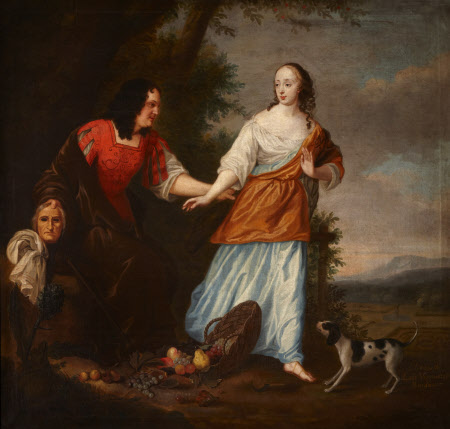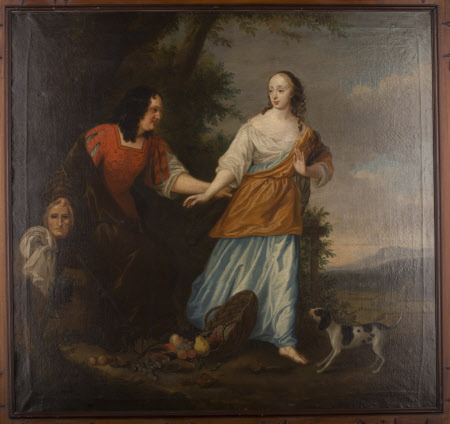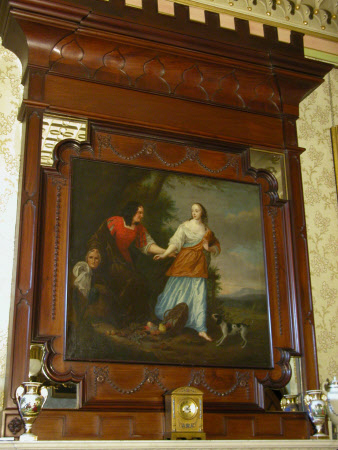John, 1st Viscount Mordaunt (1626-75) and his wife Elizabeth Carey (1632/3-1679) as Vertumnus and Pomona
Mary Hotchkis ( - d c1786
Category
Art / Oil paintings
Date
Dec 1744 (before)
Materials
Oil on canvas
Measurements
1321 x 1321 mm (52 x 52 in)
Order this imageCollection
Castle Ward, County Down
NT 836191
Caption
This dramatic painting is a rarity for being one of the few 18thcentury copies signed by the artist. That it is by the otherwise little-known painter Mary Hotchkis, and reproducing the work of another woman, makes it all the more remarkable. Hotchkis appears to have been self-taught, possibly with the help of Stephen Slaughter (1697–1765), an artist and Surveyor of the King’s Pictures who painted a descendant of the Mordaunts in 1744. Her copy of Vertumnus and Pomona must have been completed before Hotchkis married Thomas Grace in December 1744, as thereafter she exhibited under her married name. Along with artists such as Maria Cosway (1760–1838), Hotchkis was viewed by contemporaries as an exemplar of female professional independence. In 1762 she exhibited several works with the Incorporated Society of Artists. Elizabeth is probably depicted with her soon-to-be husband, John, Viscount Mordaunt. Vertumnus and Pomona were Roman deities of the seasons, trees and fruit of the orchard. According to Ovid, Vertumnus disguised himself as an old woman in order to infiltrate the garden of his beloved Pomona and woo her. The painting is unusual in depicting the moment at which a desperate Vertumnus drops his disguise and reaches for the startled goddess, who has previously rejected his advances. Pomona is shown as if about to flee, her fruit basket dropped in surprise. In Ovid’s version, her heart is finally captured by her youthful suitor. The Mordaunts were staunch Royalists and at the heart of a spy ring known as the Great Trust, Elizabeth passing messages directly between her husband and the future king Charles II (1630–85). Elizabeth probably sat for Princess Louise in The Hague. Both the original painting and Hotchkis’s copy descended through the families of Elizabeth Carey’s daughters.
Summary
Oil painting on canvas, before 1744 after an original by Louise Hollandine of the Palatinate dated 1656. Elizabeth Carey (1632/3-1679), probably with her suitor John,1st Viscount Mordaunt (1626-75), as Vertumnus and Pomona. The couple married on 7 May 1657.
Full description
Elizabeth is probably depicted with her soon-to-be husband, John Viscount Mordaunt. Vertumnus and Pomona were Roman deities of the seasons, trees and the fruits of the orchard respectively. According to the poet Ovid, Vertumnus disguised himself as an old woman in order to infiltrate the garden of his beloved Pomona and woo her. The painting is unusual in depicting the moment in which a desperate Vertumnus drops his disguise and reaches for the startled goddess who has previously rejected his advances. Pomona is shown as if about to flee, her fruit basket dropped in surprise. In Ovid’s version, her heart is finally captured by her youthful suitor. The painter Mary Hotchkis appears to have been self-taught, possibly with the help of Stephen Slaughter (1697-1765), an artist and surveyor of the King’s Pictures, who painted a descendent of the Mordaunts in 1744. Her copy of Vertumnus and Pomona must have been completed before Hotchkis married Thomas Grace in December 1744 as thereafter she exhibited under her married name.
Provenance
Purchased from Edward Ward, 7th Viscount Bangor (1903 – 1993), in 1967, with a grant from the Ulster Land Fund
Marks and inscriptions
Elizabeth Lady Viscountefs Mordaunt Mary Hotchkis copy this picter by Louisa Princefs Palatine (painted in lower right hand corner)
Makers and roles
Mary Hotchkis ( - d c1786, artist after Princess Louise Hollandine, Abbess of Maubuisson, Pontoise (1622–1709) , artist
References
Conroy, Rachel, Women Artists and Designers at the National Trust, 2025, pp. 58-9


